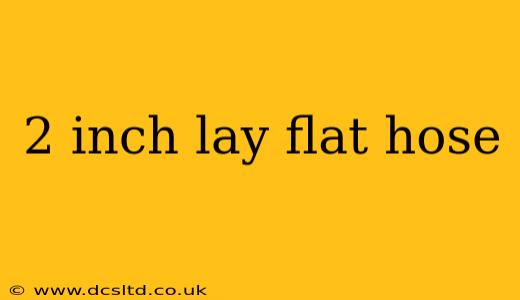Choosing the right lay flat hose can be crucial for various applications, from agriculture and construction to industrial uses and even firefighting. A 2-inch lay flat hose offers a substantial diameter, capable of handling significant water volume and pressure. This comprehensive guide will delve into the key factors to consider when selecting a 2-inch lay flat hose, answering your most pressing questions and ensuring you make the best choice for your specific needs.
What is a 2-Inch Lay Flat Hose Used For?
A 2-inch lay flat hose is a versatile piece of equipment with a wide range of applications. Its larger diameter allows for efficient transfer of substantial quantities of water or other liquids over long distances. Some common uses include:
- Irrigation: Large-scale agricultural operations often rely on 2-inch lay flat hoses to efficiently irrigate vast fields. The high flow rate ensures crops receive adequate water even across expansive areas.
- Construction: De-watering sites, supplying water to concrete mixers, and general site cleaning are all tasks effectively managed with a 2-inch lay flat hose.
- Industrial Applications: Many industrial processes require the movement of large volumes of liquids, and a 2-inch lay flat hose is ideally suited for these tasks. Think of things like chemical transfer or industrial cleaning.
- Firefighting: While not the primary hose used in firefighting, 2-inch lay flat hoses can play a supplementary role, particularly for supplying water to remote locations or for large-scale operations.
- Emergency Response: In emergencies, a 2-inch lay flat hose can be used for water supply in case of natural disaster.
What are the Different Materials of 2-Inch Lay Flat Hoses?
The material of your lay flat hose significantly impacts its durability, lifespan, and resistance to various conditions. Common materials include:
- PVC (Polyvinyl Chloride): A popular choice due to its affordability and relative durability. PVC hoses are lightweight and easy to handle but can be susceptible to damage from extreme temperatures and UV exposure.
- Polyethylene (PE): Offers superior flexibility and resistance to chemicals compared to PVC. PE hoses are typically more durable and have a longer lifespan, especially in harsh conditions.
- Rubber: Provides exceptional durability and resistance to abrasion, making it a suitable choice for demanding applications. Rubber hoses are more expensive but offer a significantly longer lifespan.
How Long Do 2-Inch Lay Flat Hoses Last?
The lifespan of a 2-inch lay flat hose depends heavily on the material, usage, and storage conditions. Proper maintenance and storage can extend their life considerably. Generally, you can expect:
- PVC hoses: 3-5 years with proper care.
- PE hoses: 5-7 years or longer.
- Rubber hoses: 10+ years, depending on usage.
What is the Best 2-Inch Lay Flat Hose for Irrigation?
The best 2-inch lay flat hose for irrigation will depend on the size of your field, water pressure, and budget. A polyethylene hose is often preferred for its durability and resistance to UV degradation, crucial for prolonged exposure to sunlight. Consider hoses with reinforced walls for added strength and longevity.
How Much Does a 2-Inch Lay Flat Hose Cost?
The cost of a 2-inch lay flat hose varies greatly depending on the length, material, and brand. Prices can range from a few hundred dollars for shorter lengths of PVC hoses to over a thousand dollars for longer, high-quality rubber hoses.
How to Choose the Right 2-Inch Lay Flat Hose?
Selecting the ideal 2-inch lay flat hose involves careful consideration of several key factors:
- Application: Identify the specific task(s) the hose will perform. This will guide the choice of material and durability requirements.
- Length: Determine the required length based on your application's reach.
- Material: Consider the material's durability, resistance to chemicals, temperature tolerance, and UV resistance.
- Working Pressure: Choose a hose with a working pressure rating that exceeds the anticipated pressure in your system.
- Connections: Ensure the hose's fittings are compatible with your existing equipment.
- Budget: Balance cost with the required quality and durability.
By carefully considering these factors, you can select a 2-inch lay flat hose that meets your specific needs and provides years of reliable service. Investing in a high-quality hose is a worthwhile decision that will save you time, money, and frustration in the long run.
